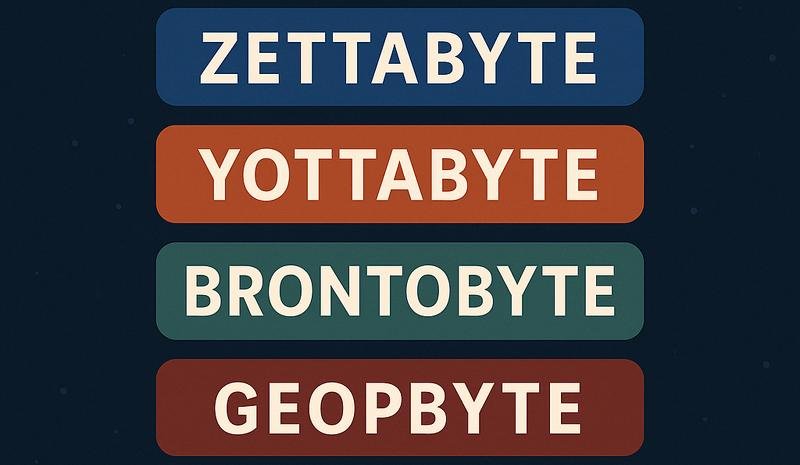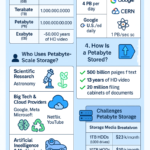Click here to buy secure, speedy, and reliable Web hosting, Cloud hosting, Agency hosting, VPS hosting, Website builder, Business email, Reach email marketing at 20% discount from our Gold Partner Hostinger You can also read 12 Top Reasons to Choose Hostinger’s Best Web Hosting
When you see headlines like “global data will hit 200 ZB by 2025,” it’s easy to feel lost in a sea of zeros. Most of us know terabytes and petabytes, but once you hit exabytes, the names—and the scale—become almost mythical. As organizations grapple with ever‑growing datasets, misunderstanding these units can lead to under‑provisioned infrastructure, budget overruns, or missed opportunities in data‑driven projects. In this guide, you’ll learn exactly what comes after Exabyte, how these colossal units map to real‑world scenarios, and why understanding them matters for planning the next generation of storage and compute.
Here is a comprehensive guide about 7 early warning signs of Hard Drive Failure and a sure-shot solution to recover lost or deleted data. Plus, this software allows you to recover formatted partition.
Understanding the Exabyte
An Exabyte (EB) represents 10<sup>18</sup> bytes (one quintillion bytes), or 1,000 petabytes. To put it in perspective:
Streaming 4K video for one hour uses about 7 GB of data.
You would need 143 million hours of 4K streaming to consume 1 EB.
Enterprises like CERN’s Large Hadron Collider generate petabytes of data annually; exabyte‑scale storage is already critical in genomics, climate modeling, and global social‑media archives.
You can use Windows Disk Management and PowerShell for initialization, partition and format your drive, securely erase data, monitor SSD health, physically install new hardware, and resolve detection or performance issues.
What Comes After Exabyte?

1. Zettabyte (ZB)
Definition: 10<sup>21</sup> bytes (1,000 exabytes)
Real‑World Lens: In 2016, global IP traffic officially surpassed 1.2 ZB, marking the start of the “Zettabyte Era” for networked data Wikipedia.
Use Case: Cloud providers plan infrastructure growth around zettabyte projections—AWS, Azure, and Google Cloud each store tens of zettabytes across regions.
2. Yottabyte (YB)
Definition: 10<sup>24</sup> bytes (1,000 zettabytes)
Perspective: Still theoretical for most, but scientific archives (e.g., square‑kilometer array radio telescopes) could amass yottabytes over decades.
3. Brontobyte (BB) (Unofficial)
Definition: 10<sup>27</sup> bytes (1,000 yottabytes)
Origin: Coined by data‑community forums to name the next logical scale. While not recognized by ISO/IEC standards, it helps conceptualize astronomical storage demands in genomics and physics.
4. Geopbyte (GPB) (Unofficial)
Definition: 10<sup>30</sup> bytes (1,000 brontobytes)
Why It Matters: In a future dominated by hyper‑AI and planetary‑scale simulations, geopbytes could describe aggregate data across entire industries or digital twins of Earth.
Beyond Geopbyte: Some enthusiasts propose even larger names (e.g., Saganbyte for 10<sup>36</sup>), but these remain playful conjectures for now.
What Comes After Petabyte? Discover Exabyte, Zettabyte & More
Why Naming Matters: Implications for Tech and Strategy
Procurement & Budgeting: CIOs need clear terms when negotiating exabyte‑ or zettabyte‑level SLAs.
Capacity Planning: Data‑center engineers must forecast growth—projected to exceed 200 ZB by 2025, according to Cybersecurity Ventures.
Standards & Interoperability: Consistent naming aligns hardware vendors, cloud platforms, and software tools, reducing misconfigurations in multi‑cloud deployments.
Communication Clarity: When you tell stakeholders “we need a zettabyte backup solution,” you avoid the hand‑wringing that comes with “a lot of storage.”
Forecasting the Storage Landscape
By 2025: Total global storage demand is set to top 200 ZB, driven by AI training, IoT, and video streaming.
Energy & Sustainability: Zettabyte‑era data centers already consume a significant portion of global power. Future geopbyte infrastructures will hinge on breakthroughs in energy‑efficient storage and renewable‑powered facilities.
Regulatory Impact: As data scales explode, jurisdictions worldwide will tighten rules on data localization, privacy, and cross‑border transfer—requiring zettabyte‑aware governance frameworks.
Case Study: Big Science, Big Numbers
The Square Kilometre Array (SKA) radio telescope, slated to come online in the late 2020s, is expected to generate exabytes per day of raw sensor data. Without zettabyte‑class archives and geopbyte‑scale analytics platforms, processing such volumes will stall one of humanity’s most ambitious scientific endeavors.
Lost Your Files? 7 Best Free Hard Disk Data Recovery Software to Rescue Your Data Now
Key Takeaways
Zettabyte (ZB) follows exabyte, defined as 1,000 EB. Cisco Blogs
Yottabyte (YB) caps the current official scale (10<sup>24</sup> bytes).
Brontobyte & Geopbyte are community‑coined terms for 10<sup>27</sup> and 10<sup>30</sup> bytes.
200 ZB by 2025: Global storage demand is skyrocketing, with AI and IoT as main drivers. Cybercrime Magazine
Strategic Planning: Understanding these scales is vital for budgeting, capacity planning, and compliance.
FAQs
1. What are the official data units recognized by standards bodies?
ISO/IEC recognizes up to Yottabyte (10<sup>24</sup> bytes). Units beyond that (Brontobyte, Geopbyte) are informal but help bridge conceptual gaps for extreme scales.
2. How many exabytes equal one zettabyte?
1 Zettabyte = 1,000 Exabytes.
3. Will we ever need geopbyte‑scale storage?
As AI, IoT, and scientific instruments generate ever‑more detailed datasets, geopbyte‑scale capacities may become practical by the 2030s—especially in digital‑twin and Earth‑system modeling workflows.
4. How can organizations prepare for zettabyte‑era data?
Start by auditing current storage growth rates, consolidating unused datasets, and investing in scalable, energy‑efficient architectures that can grow seamlessly into the zettabyte realm.
A petabyte is already mind-bogglingly large—so what lies beyond it? In short, after petabyte comes exabyte, followed by zettabyte, yottabyte, and then the newly ratified ronnabyte and quettabyte, with informal names like brontobyte and geopbyte floating around. You’ll learn exact definitions, real-world analogies, practical use cases, and growth forecasts for each unit. We’ll also answer sub-questions like “What is 1000 TB called?” and “How much is a brontobyte?” to equip you with a crystal-clear understanding of today’s and tomorrow’s data scale.
Conclusion
Grasping what comes after Exabyte isn’t just an exercise in big‑number trivia—it’s a practical necessity for anyone designing tomorrow’s data ecosystems. From corporate archives to interstellar telescopes, knowing your ZBs from your YBs (and beyond) ensures you can plan infrastructure, budgets, and governance with confidence. Explore more on SmashingApps.com—whether you’re architecting a zettabyte backup solution or simply curious how data scales will shape our digital future.
Ready to tackle exabyte‑scale challenges? Check out our Guide to Big Data Management and subscribe for updates on the next frontier of storage.
Now loading...






